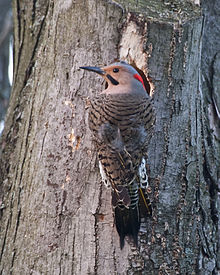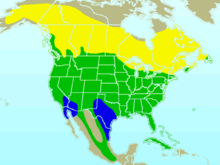Northern flicker
| Northern flicker | |
|---|---|
 |
|
| Female C. a. auratus | |
 |
|
| Male C. a. auratus | |
| Scientific classification | |
| Kingdom: | Animalia |
| Phylum: | Chordata |
| Class: | Aves |
| Order: | Piciformes |
| Family: | Picidae |
| Genus: | Colaptes |
| Species: | C. auratus |
| Binomial name | |
|
Colaptes auratus (Linnaeus, 1758) |
|
 |
|
| Summer only range Winter only range Year-round range | |
| Synonyms | |
|
|
The northern flicker (Colaptes auratus) is a medium-sized member of the woodpecker family. It is native to most of North America, parts of Central America, Cuba, and the Cayman Islands, and is one of the few woodpecker species that migrate. Over 100 common names for the northern flicker are known. Among them are: "yellowhammer" (not to be confused with the Eurasian yellowhammer), clape, gaffer woodpecker, harry-wicket, heigh-ho, wake-up, walk-up, wick-up, yarrup, and gawker bird. Many of these names are attempts at imitating some of its calls.
The northern flicker is part of the genus Colaptes, which encompasses 12 New World woodpeckers. Nine subspecies and one extinct subspecies of C. auratus are recognized. The existing subspecies were at one time considered separate species, but they commonly interbreed where ranges overlap and are now considered one species by the American Ornithologists Union. This is an example of the "species problem".
C. a. cafer: female (left), male (right)
C. a. chrysocaulosus
female, Cuba
Adults are brown with black bars on the back and wings. A mid- to large-sized woodpecker measures 28–36 cm (11–14 in) in length and 42–54 cm (17–21 in) in wingspan. The body mass can vary from 86 to 167 g (3.0 to 5.9 oz). Among standard scientific measurements, the wing bone measures 12.2–17.1 cm (4.8–6.7 in), the tail measures 7.5–11.5 cm (3.0–4.5 in), the bill measures 2.2–4.3 cm (0.87–1.69 in) and the tarsus measures 2.2–3.1 cm (0.87–1.22 in). The largest-bodied specimens are from the northern stretches of the species range, at the latitude of Alaska and Labrador, while the smallest specimens come from Grand Cayman Island. A necklace-like black patch occupies the upper breast, while the lower breast and belly are beige with black spots. Males can be identified by a black or red moustachial stripe at the base of the beak. The tail is dark on top, transitioning to a white rump which is conspicuous in flight.
...
Wikipedia

